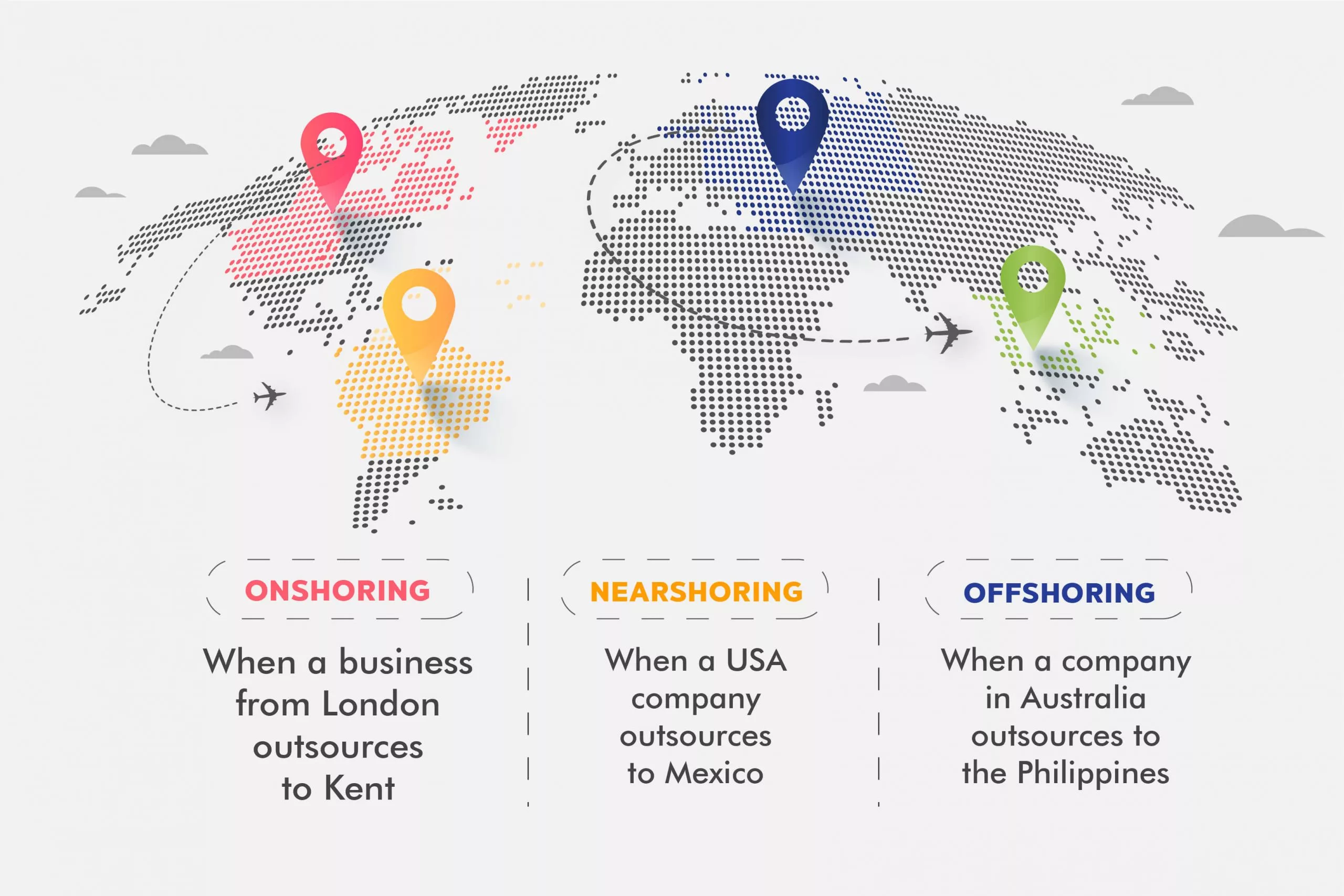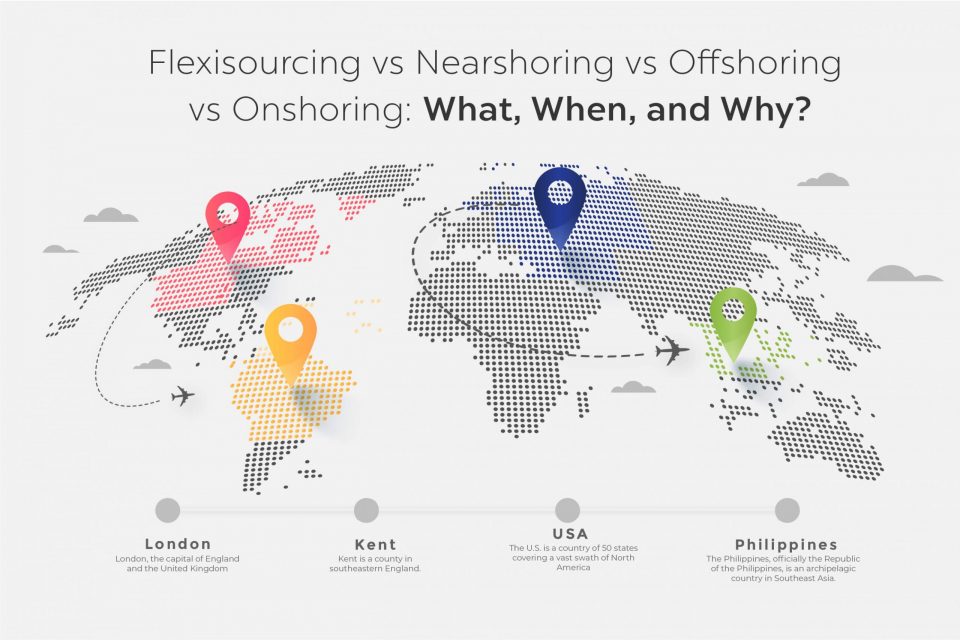Looking for the right team to build a new tech product can be challenging for tech companies. Whether a website development or Internet of Things (IoT) application, you’ll need to watch the development process to ensure that the product is high-quality and running smoothly.
However, a Tech Leader often does not have the time to handle the development process and run a business simultaneously. Some businesses often choose to outsource when developing a new product.
However, Outsourcing has different types of more viable solutions, such as Offshoring, Nearshoring, Onshoring, and Flexible Outsourcing or Flexisourcing. This article will tackle the difference between the four outsourcing models, nearshoring vs offshoring, onshoring vs offshoring, offshoring vs outsourcing, understand the risks and benefits, advantages and disadvantages, and select when meeting your business needs.
Table of Contents
Nearshoring vs Offshoring vs Onshoring vs Flexisourcing: What are the differences?
Understanding the difference between Nearshoring vs Offshoring vs Onshoring vs Flexisourcing is essential to save time, resources, and stress that comes with the recruiting process. Luckily, these four models are much more common and similar than you think.
While they all represent a similar concept of getting a third-party company, each outsourcing strategy comes with its strength and weakness.
What is Onshore Outsourcing (Domestic Outsourcing)?

Onshore Outsourcing (domestic outsourcing) or onshoring is the process of hiring a third-party business located in your country. Onshoring usually involves transferring your company’s business operation or software development to a non-metropolitan area within your country at an affordable cost.
Onshoring: Advantages and Disadvantages
Onshore outsourcing is almost the exact opposite of offshore outsourcing. Since the third-party company is located in your country, Onshoring provides the most significant security from the associated risk that Outsourcing comes with. It can provide better coordination, safety, and control. Onshoring is the ideal choice in recruiting a competent workforce for starting companies or individuals to complete a project.
Advantages of Onshoring:
- Similar Time zone
Having a similar time zone with your outsourced company can reduce delays in software development. Your team is reachable during work hours, and any issues or changes can be communicated quickly.
- Ease of Control and Communication
Hiring a workforce in your own country can provide transparent and more accessible communication. Hence, any issue that arises in developing software can be discussed and solved quickly.
In addition, travelling to their office is inexpensive and more straightforward. You can travel effortlessly to hold onsite meetings and check their work and progress regularly. In-person communication can increase the productivity of developers. Onshoring gives you better control of the project.
- Cultural compatibility
Unlike other outsourcing models, cultural differences are not an issue with onshoring. Both parties will speak the same languages and have similar values since both parties are located in the same country. Miscommunication can be avoided in delegating tasks and communicating with your team.
It also saves you the time and effort to learn different cultures, traditions, and languages.
- Secure Data and Trade Secrets
Onshore Outsourcing offers the best security when it comes to data privacy and piracy. Since the third-party company is located in your country, you follow the same data privacy law and regulations. You have the ease of mind that any information given to them is safe from being sold or shared with other companies. It is also easier to reach any case of information breach as you are more familiar with the law.
- Investment in local business
Hiring a local business from your own country is also helping your country in the long run. You effectively boosted your country’s economy by hiring a local company by paying taxes and giving jobs to locals and the native workforce.
Disadvantages of Onshoring:
- Limited talent pool
Hiring locally also restricts the talent pool you access. Different countries have their issue with the supply of professionals or experts. There may not be enough candidates that have the necessary skill sets you are looking for. In addition, recruitment and training can be lengthy, following the requirements and regulations given by the government.
- Higher costs
Onshoring is much more expensive than other business models. Since you are hiring locally, professionals have a higher salary standard. This can be a massive setback for startups and small businesses.
Does Onshore work for your business?
In conclusion, domestic outsourcing or onshoring is a great outsourcing model that utilizes resources in the same country without dealing with the hindrances of other business models. Onshoring can increase efficiency, productivity, and product development without setting back your own company’s resourcing.
Onshoring is ideal for companies needing outside resources for lower cost but wants to work closely to ensure the delivery and quality of software. Due to its price, onshoring is perfect for medium to large-scale businesses that are stable with more prominent resources.
What is Nearshore Outsourcing?

Nearshore Outsourcing or Nearshoring are frequently mistaken as offshore outsourcing due to their geographic location, which is why business owners often compare nearshoring vs offshoring. To simplify, the nearshoring definition is when a company outsourced resources from a nearby country, preferably from the same continent. For example, a company located in Australia may outsource a service to an agency in New Zealand.
Nearshoring: Advantages and Disadvantages
Nearshoring has similarities with onshoring when it comes to its advantages and disadvantages. IT Nearshoring is common in Australia due to the shortage of skilled IT workers. Services that are best for nearshore software outsourcing include software development, technical support and call center jobs.
Advantages of Nearshoring
- Comfortable time zone
Like onshoring, having the same time zone with your outsourced company allows better collaboration and communication throughout the workday. Bottlenecks encountered during the day avoid delays.
The external team can respond quickly to inquiries, changes, and new requirements. There is no need to adjust your working schedule and work late at night to communicate with your team.
- Easier Control and Travel
The proximity also allows company visits reduced travel costs and shorter flights than can be completed in a day. It’s easier to hop on a short flight, meet the team, and return home in the evening.
This lets both parties have a face-to-face meeting more frequently, keeping team spirit high. You can also invite the development team to your headquarters.
- Few cultural and language barriers
Workers from nearby countries often know your traditions or at least understand the language of your country. For example, the United States and Mexico share several cultural similarities, social norms, and languages. It is easier to work together and collaborate when employees can relate with each other.
Aside from that, most workers from countries that offer nearshore outsourcing speak English Proficiently.
- Access to more talent pools
Skilled experts in your countries might be minimal, limited, or high-priced. Nearshoring provides greater access to talent pools of high-quality experts outside of your country for a lower price.
- Cost-effective
Nearshoring offers a cost-effective solution without worrying about the setbacks that Offshoring gives. Depending on the location of the third-party company, labor costs can be minimal.
Disadvantages of Nearshoring
- Low proficiency
Often but not always, some developing countries do not have the best educational system. Thus, when nearshoring a service, you need to ensure that the third-party companies have competent developers and produce high-quality products.
- Poor Organizational Skills
Organizational hierarchy might be an issue to the outsourcing company if they look for a partnership rather than subordination or employees.
In addition, it is harder to control the business if it’s located in another country. You need to ensure that the project manager pays enough attention to the workflow and check progress.
- Less convenience
In some cases, working long distances is not convenient for software development. For example, troubleshooting an error may require an onsite collaboration. Virtual communication may also be more complex when dealing with issues.
Does Nearshoring work for your business?
Choosing the best outsourcing model for your business can be difficult. The selection of the software outsourcing company varies significantly on your project’s features and goals.
Nearshoring is best for companies looking for cheaper outsourcing options but do not want to spend a considerable amount like onshoring. It also works great if you’re going to outsource for a lower price but doesn’t want to deal with the drawbacks brought by Offshoring.
Similarly, IT Nearshoring can offer options of skilled experts to help fill up the Gap of Software Developers in the country. Best nearshoring example i
What is Offshore Outsourcing?

Offshore Outsourcing or Offshoring is the process of relocating tasks to countries with lower labour costs which makes it the most budget-cutting expanding model available. With offshoring, the outsourced business operations are relocated to another country, geographically in distant lands. The best countries for offshore software development are Ukraine, India, and the Philippines.
Offshoring: Advantages and Disadvantages
Offshoring offers some advantages and disadvantages far similar to onshore and nearshore. Businesses that choose to go Offshoring gain both short-term and long-term benefits.
Advantages of Offshoring
- Lower costs and great financial boons
Offshoring work is a reasonable cost-cutting method for business. Hiring a partner with the same skill sets but a lower price can help a company cut down expenditures and quickly translate into profits.
Offshoring will also let you focus on the more critical aspects of your business like expanding, partnership, etc.
- Access to Global Talent Pool
Many countries are facing a shortage in the supply of IT professionals. The best solution that the world has to offer is Offshoring. Offshoring provides a wide range of choices and options from different regions of the world. You can access a vast global talent that your business can take advantage of when hiring. You can expand your staff by choosing a professional with the correct skillset and a well-organized organization for a lower price.
- Get Work Done While You Sleep
While a different time zone is often seen as a drawback, it can also be a benefit. For instance, while you are sleeping, a software developer in the Philippines is already building a solution. You can coordinate teams from different worlds to maximize efficiency and speed up the offshore development process, deploying a product faster than expected.
You can also align your working hours together. Most offshore teams are flexible and willing to work in different time zones.
Similarly, Offshoring is not limited to software development. Service like customer service and troubleshooting needs 24-hour assistance. Thus, Offshoring can help you get the right people without thinking of paying extra for late-night shifts.
Disadvantages of Offshoring
- Requires Bigger Alertness and Attention
Offshoring also means working with an offshore team across the globe. Miscommunication might often happen. Some of the team members might not always understand your instructions thoroughly. Thus, you may need to reiterate instructions of changes and constantly check their progress. Lack of regular in-person contact, such as phone and video calls, may fail development or business operations.
- No Face-to-Face Check-ins
Flying frequently is not an option in Offshoring. It can be expensive, and flights might take a day or two. You may often feel that you don’t have control over offshore software development outsourcing.
- No Feeling of Security in Ownership and Data Leaks.
Data leaks may be harder to control when Offshoring. Data Privacy laws practiced in major outsourcing locations might be different than what you expect. Commonly, offshore companies sell your most valuable information to competitors. According to the Ponemon Institute report, about 65% of companies who outsourced work to a vendor experienced a data breach, including consumer data.
Thus, it’s crucial to safeguard your information. When signing a contract, make sure there are security standards and protocols included.
- Cultural differences and Language Barriers
Miscommunication can happen due to language barriers. It can be challenging, especially when it leads to misunderstanding and shoddy work critical to your business. When offshoring companies, you need to make sure their skills in languages are at par with natives. Luckily, most offshore companies hire those who speak English perfectly.
In addition, you need to learn and adjust to specific cultures and habits with the offshore company to collaborate with them better. It’s essential to build relationships with offshore companies and avoid offending them.
- Time zones
Despite its benefits, Timezones can also create various issues in deadlines, work quality, and control. Meetings can be challenging to have as you need to adjust your work schedules.
How will Offshoring work for your business?
When you feel that your staff can’t handle added work, it’s logical to outsource a dedicated team. However, budget constraints can often prevent you from outsourcing people. Thus, Offshoring is excellent for small to large enterprises that need to outsource a small-budget job.
Offshoring is also significant when you need to outsource a business operation with extensive operations but minimal requirements like customer service, technical assistance, human resources, and more.
If you are worried about drawbacks that outsourcing offers, check these outsourcing stories plus tips on how to avoid them .
What is Flexisourcing?
Flexible Outsourcing or Flexisourcing is a new outsourcing model combining project outsourcing and remote workers consultancy. Unlike the traditional model, Flexisouring uses agile method in managing projects . It consists of flexible, dynamic, diversified outsourcing models and solutions that eradicate the constraints and limitations of traditional outsourcing models.
When Flexisourcing, the company temporarily recruits independent talents from a third-party agency for a short-term contract. Experts are not exclusively committed to a particular client. They are allowed to take additional projects from other clients.
Business is only required to pay for the skills used and the services delivered. Payment can be delivered flat rate, per hour basis, or project basis.
Flexisourcing Advantages and Disadvantages
Advantages of Flexisourcing
- Cost-Effective Operations
Since workers are not employed full-time in Flexisourcing, businesses only need to pay for every project’s service. Clients do not need to pay for benefits and allowances that usually come with the recruitment process.
Agile enables the third-party company and leading company to integrate changes quickly and correct errors promptly. Thus, Flexisourcing allows clients to demand revisions without thinking of the additional fees. With Flexisourcing, your outsourced team will be able to operate in a way that effectively adapts to any changes to your business operations.
- Flexible Work Schedule
Flexisourcing, as its name suggests, is flexible in many aspects, including work schedules. Workers can be on-call for clients and can easily be reached when the need arises. Unlike Outsourcing, where there is only a designated work schedule, Flexisourcing allows employees to work at their desired time and pace if they meet the project requirements and deadline.
- Better Control in Development
Flexisourcing lets you scan the pool of talents and choose your project manager, staff, roles, and even directly manage them. In Flexisourcing, a constant update on the development is possible using the Agile Sprint Cycle. Constant changes to meet the demand of the market are possible.
In addition, the client company may directly contact the staff without the barrier of the management. Most team in Flexisourcing works closely with the client. Thus, it will be easier to communicate any misalignment on the goal and product requirements
Any issues identified by the project managers and staff can easily be raised and suggested to the client.
Disadvantages of Flexisourcing
- Cultural Differences and Language Barriers
Despite its significant advantages, Flexisource workers are still located far from your company’s headquarters. Often, you will still face issues with cultural differences and language barriers.
- Sprint Meetings May Eat uptime.
Flexisourcing uses the agile method that includes sprints meeting after every duration. The regular meeting might eat up your time doing other tasks or improve other parts of your business.
How will Flexisourcing work for your business?
Flexisourcing is the best outsourcing methodology for a product or operation that needs constant changes. With Agile Methodology, any changes or requests can easily be implemented—services like Software and Website Development, Digital Marketing, Content Creation, and Management. Read more about the difference between flexisourcing and outsourcing.
What’s the Best Outsourcing Model for your Business?

To sum up, It may seem that the primary distinction between Nearshoring vs Offshoring vs Onshoring vs Flexisourcing is only the location. Here’s a TL;DR for you:
- If a business from London outsources to Kent, that’s onshoring;
- If a USA company outsources to Mexico, that’s nearshoring; and,
- If a company in Australia outsources to the Philippines, that’s offshoring.
But in today’s world of cyberspace, the location of the outsourcing company should be the least of concern. Each type has a significant benefit and drawback. You can pick the one that perfectly fits your needs by factoring in your goals, resources, and project requirements. Set up your priorities straight and define what you are aiming for.
So, if you are looking for an outsourcing model that is flexible, reliable, and agile, try Flexisourcing now. Get in touch with us today.
Pamela is a full-time content writer and a lifelong Philomath. Her previous experience as a research analyst made her passionate about traveling the world and understanding how it works. During her day off, you can often find her indoors, writing stories or oil painting.


